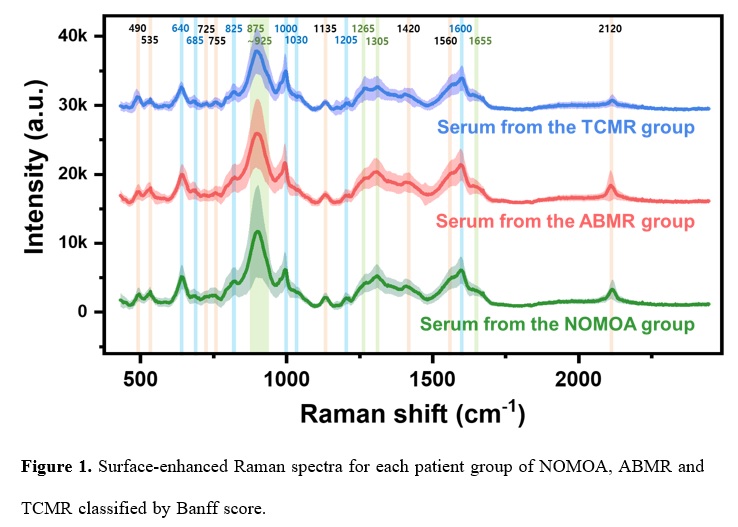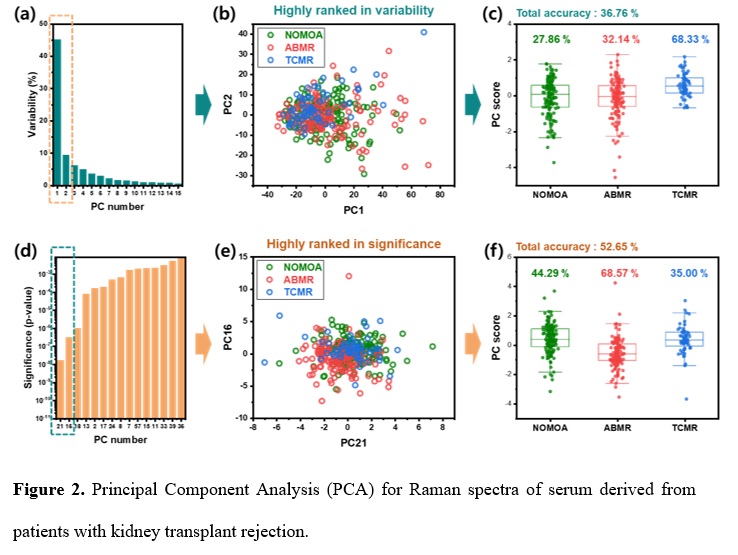Diagnosis and classification of kidney transplant rejection via surface-enhanced raman spectroscopy combined with machine learning techniques from a single drop of serum
Jin-Myung Kim1, Sanghwa Lee2, Kwanhee Lee3, Haeyon Cho4, Sung Shin1, Jun Ki Kim2.
1Department of Surgery, Asan Medical Center, Seoul, Korea; 2Biomedical Engineering Research Center, Asan Medical Center, Seoul, Korea; 3Department of Convergence Medicine, Asan Medical Center, Seoul, Korea; 4Department of pathology, Asan Medical Center, Seoul, Korea
Introduction: Differentiating between antibody-mediated rejection (ABMR) and T-cell-mediated rejection (TCMR) in kidney transplant patients is critical for determining the appropriate therapeutic strategy. The standard diagnostic approach, invasive biopsy, carries risks and may not always provide an early diagnosis. This study evaluates a novel, non-invasive diagnostic method utilizing surface-enhanced Raman spectroscopy (SERS) combined with machine learning techniques to accurately classify rejection types from serum samples.
Method: The study analyzed serum samples from kidney transplant patients grouped into no major abnormality (NOMOA), ABMR, and TCMR categories, based on biopsy tissue analysis and Banff scores. A single drop of blood samples was applied and examined using an Au-ZnO nanorod-based SERS chip, with the resulting Raman spectroscopy signals processed using Principal Component-Linear Discriminant Analysis (PC-LDA) and Principal Component-Partial Least Squares Discriminant Analysis (PC-PLSDA).
Results: The application of PC-LDA resulted in a diagnostic accuracy of 93.53%, while PC-PLSDA achieved an even higher accuracy of 98.82%. Specifically, the study identified critical biomarkers contributing to this high level of diagnostic precision. Collagen signals, indicative of kidney injury, were identified alongside creatinine and amino acid-derived signals, which are known markers of kidney function. The differentiation accuracies for ABMR and TCMR versus NOMOA were particularly noteworthy, with PC-LDA demonstrating 92.14% for ABMR and 96.67% for TCMR. These findings underscore the method's capability to detect and analyze a broad spectrum of biomarkers, significantly contributing to its high diagnostic performance.
Conclusion: The proposed diagnostic system demonstrates a high accuracy rate in distinguishing between ABMR and TCMR kidney transplant rejections using a non-invasive serum-based approach. This method offers a promising alternative to invasive biopsy procedures, allowing for early and precise diagnosis of rejection types, which is critical for the timely management and treatment of kidney transplant patients. Further research is warranted to validate this approach in larger patient cohorts and to explore its integration into clinical practice.


[1] Raman spectroscopy
[2] Novel biomarkers
